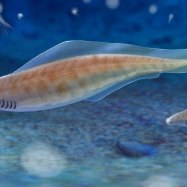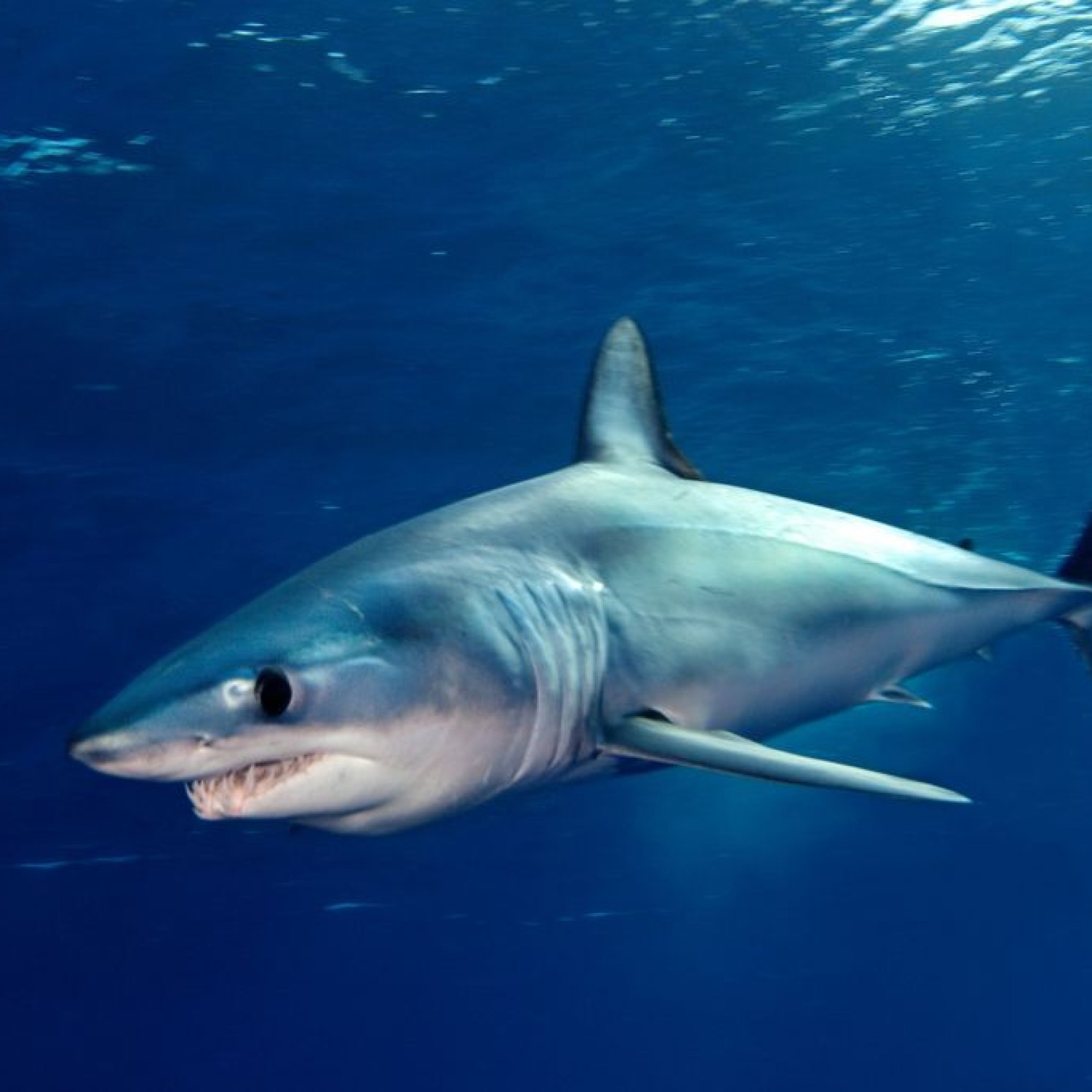
Longfin Mako Shark
Up to 13 feet (4 meters)
The Longfin Mako Shark is a magnificent creature found in the open ocean. With a length of up to 13 feet, or 4 meters, this shark belongs to the Lamnidae family and has a streamlined and elongated body shape. Despite its size, it is known for its impressive speed and agility, making it a top predator in its habitat. Keep an eye out for this impressive animal on your next ocean adventure. #LongfinMakoShark #OpenOceanExploration #LamnidaeFamily
Animal Details Summary:
Common Name: Longfin Mako Shark
Kingdom: Animalia
Habitat: Open ocean
A Majestic Creature of the Open Ocean: The Longfin Mako Shark
The ocean is home to countless breathtaking creatures, from tiny colorful fish to massive humpback whales. Among them, one species stands out for its incredible speed, powerful jaws, and impressive size - the longfin mako shark. This fascinating animal, with its scientific name Isurus paucus and more commonly known as the longfin mako shark, has captured the attention of marine enthusiasts and researchers alike. In this article, we will dive deeper into the world of this majestic creature and discover its unique characteristics and adaptations that make it such an extraordinary animal Longfin Mako Shark.An Overview of Longfin Mako Shark
The longfin mako shark belongs to the animal kingdom, Animalia, and the phylum Chordata, which includes all vertebrate animals. It also falls under the class Chondrichthyes, meaning it is a cartilaginous fish with a skeleton made of cartilage instead of bones. This species belongs to the Lamniformes order, also known as the mackerel sharks, and the Lamnidae family, which includes other fierce predators such as the great white shark and the shortfin mako shark.This incredible creature is mostly found in the open ocean, making it a pelagic species. It can be found in all the world's oceans, from tropical to temperate waters, and has a wide geographical distribution. However, its country of origin remains uncertain, although it is believed to be primarily found in temperate and subtropical waters.
Habitat and Adaptations
As mentioned earlier, the longfin mako shark is a pelagic species, meaning it lives in the open ocean and does not stay close to the seafloor. Its habitat is mostly in the deep waters of the ocean, where it can reach depths of up to 500 meters (1640 feet). However, it is often found in shallower waters as well, particularly when hunting for prey Lancetfish.One of the most impressive adaptations of the longfin mako shark is its streamlined and elongated body shape. This unique body shape allows it to move effortlessly through the water, reaching incredible speeds of up to 60 miles per hour (96 kilometers per hour). This makes it one of the fastest fish in the ocean, second only to its close relative, the shortfin mako shark.
The longfin mako shark also has a unique coloration, with a deep blue color on its dorsal side and a contrasting white color on its ventral side. This coloration helps the shark blend into its environment, making it harder for prey to spot it from above or below. This adaptation gives the longfin mako shark an advantage when hunting, allowing it to surprise its prey.
Nutrition and Hunting Strategy
The longfin mako shark is a carnivorous species, meaning it feeds on other animals. Its diet primarily consists of fish, such as tuna, mackerel, and swordfish. It is also known to prey on other sharks, squid, and even seabirds.This shark is a formidable predator, thanks to its incredible speed and powerful jaws. It uses its speed to chase down its prey, often launching itself out of the water to capture fast-moving fish from below. Once caught, its sharp teeth and powerful jaw muscles allow it to tear through its prey's flesh quickly. Unlike other sharks, the longfin mako shark can maintain its body temperature above the surrounding water temperature, giving it an advantage when hunting in colder waters.
Threats and Conservation
Despite its impressive capabilities and wide geographical distribution, the longfin mako shark is considered an endangered species. Its population has significantly declined due to overfishing, with the demand for its meat, fins, and liver oil being the main cause. This shark's long fins are particularly sought after because of their high value in the shark fin trade, driven by the demand for shark fin soup in some Asian countries.The longfin mako shark is also caught as bycatch, unintentionally caught in fishing nets used to catch other species. Its slow reproductive rate also makes it vulnerable to overfishing. Female longfin mako sharks reach sexual maturity at around 18-20 years of age and only give birth to an average of 4-25 pups. This slow reproductive rate makes it challenging for the species to recover from population declines.
To address these threats, various conservation efforts have been implemented. In 2019, the longfin mako shark was listed under Appendix II of the Convention on International Trade in Endangered Species of Wild Fauna and Flora (CITES), meaning its international trade is closely monitored and regulated. Many countries have also implemented fishing restrictions and bans on the targeted fishing of this species.
In Conclusion
The longfin mako shark is truly a remarkable creature of the open ocean. Its incredible speed, powerful jaws, and adaptations make it one of the most fascinating predators in the marine world. However, its declining population highlights the urgent need for conservation efforts to protect this species from extinction. As we continue to learn more about the longfin mako shark and other marine creatures, let us also strive to conserve and protect these magnificent animals for future generations to admire and appreciate.

Longfin Mako Shark
Animal Details Longfin Mako Shark - Scientific Name: Isurus paucus
- Category: Animals L
- Scientific Name: Isurus paucus
- Common Name: Longfin Mako Shark
- Kingdom: Animalia
- Phylum: Chordata
- Class: Chondrichthyes
- Order: Lamniformes
- Family: Lamnidae
- Habitat: Open ocean
- Feeding Method: Carnivorous
- Geographical Distribution: Global
- Country of Origin: Uncertain, but likely in temperate and subtropical waters
- Location: Open ocean
- Animal Coloration: Deep blue on the dorsal side and white on the ventral side
- Body Shape: Streamlined and elongated
- Length: Up to 13 feet (4 meters)
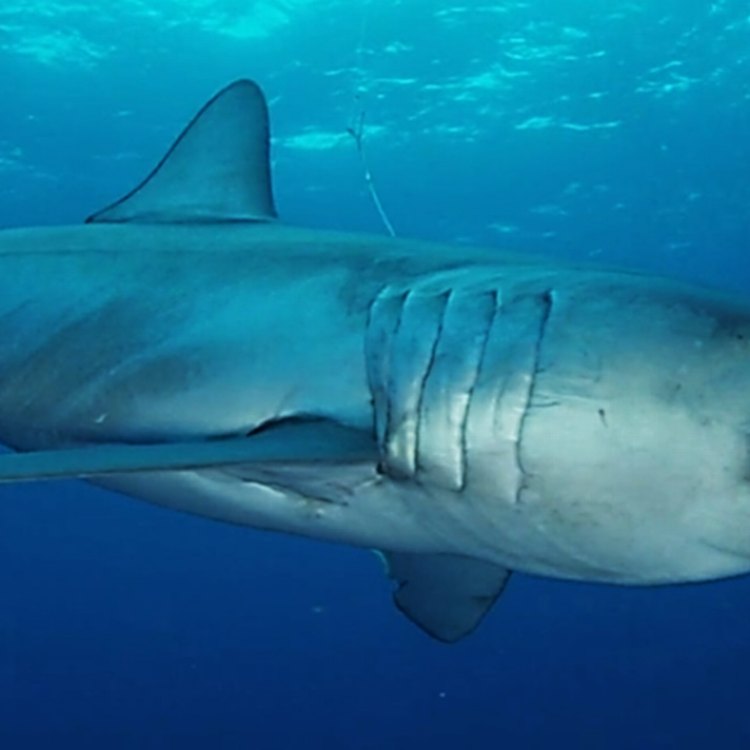
Longfin Mako Shark
- Adult Size: Unknown
- Average Lifespan: Unknown
- Reproduction: Ovoviviparous
- Reproductive Behavior: Unknown
- Sound or Call: Unknown
- Migration Pattern: Unknown
- Social Groups: Unknown
- Behavior: Aggressive and fast-swimming
- Threats: Overfishing, habitat destruction, and bycatch
- Conservation Status: Data Deficient
- Impact on Ecosystem: Apex predator
- Human Use: Fishing (commercial and recreational)
- Distinctive Features: Long, slim, and flexible pectoral fins
- Interesting Facts: The longfin mako shark is a rare and poorly understood species. Its long fins distinguish it from other mako sharks.
- Predator: Unknown
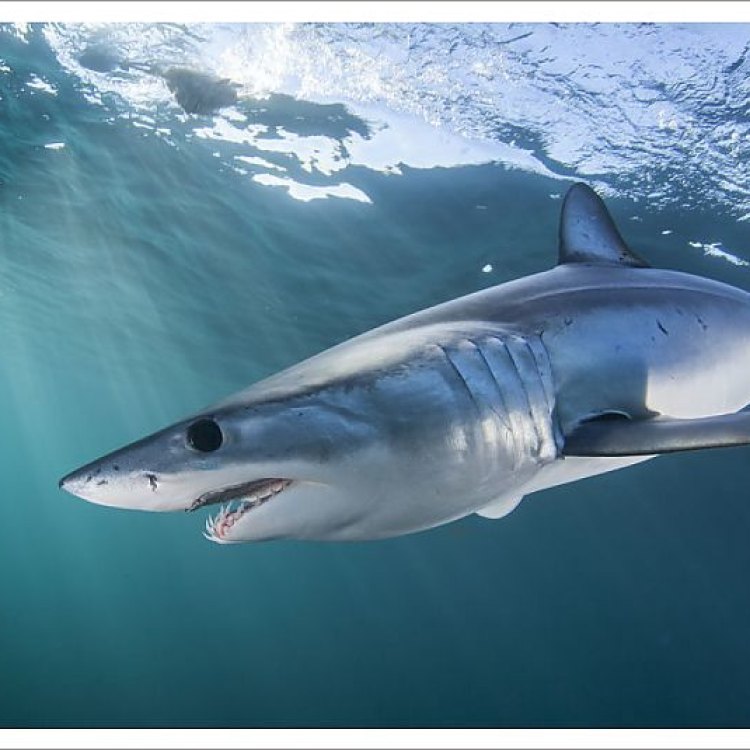
Isurus paucus
The Mysteries of the Longfin Mako Shark: Diving into the Deep Waters of the Unknown
The deep, vast oceans hold a plethora of creatures, some of which are known and studied extensively, while many others remain a mystery. Among these mysterious creatures is the longfin mako shark, a rare and poorly understood species that roams the ocean depths. With its long, slim, and flexible pectoral fins, this shark is distinguished from other mako sharks and is a fascinating and elusive creature that continues to captivate both scientists and the general public alike.Uncovering the secrets of the longfin mako shark is like solving a puzzle with missing pieces - challenging, yet exhilarating PeaceOfAnimals.Com.
So, let's dive into the deep waters of the unknown and discover the mysteries surrounding this unique shark species.
The Elusive Longfin Mako Shark
The longfin mako shark, also known as the long-fin mako or bigfin mako, is a rare and little-known species of mackerel shark belonging to the family Lamnidae. It can be found in temperate and tropical waters worldwide, with sightings in the Atlantic, Pacific, and Indian Oceans.
Despite its widespread distribution, very little is known about the longfin mako shark. In fact, its adult size and average lifespan are still unknown, making it a challenging species to study. However, some researchers estimate that it can reach up to 3.5 meters (11.5 feet) in length, similar to its closest relative, the shortfin mako shark.
Reproduction and Behavior: A Mysterious Process
One of the most intriguing aspects of the longfin mako shark is its reproductive behavior Larder Beetle. Like other mackerel sharks, it is ovoviviparous, meaning the embryos develop inside eggs that hatch inside the female's body, where the pups then receive nutrients until birth.
However, the specifics of their reproductive behavior, including mating and gestation periods, are still unknown. The longfin mako shark remains a mysterious creature, making it a challenging task for scientists to gather information about its reproductive process.
The Call of the Deep Waters
Another enigma surrounding the longfin mako shark is its sound or call. Generally, scientists use acoustic monitoring to track and study shark species, but there have been no reports of the longfin mako displaying any vocalizations. This could be due to their elusive nature or their deep-sea habitat, where sound does not travel as well as in shallow waters.
Following the Mystery Migration Pattern
Most shark species, particularly those that are commercially fished, have well-documented migration patterns. But for the longfin mako shark, this remains a mystery. While some individuals may migrate long distances to find food or mating partners, others may reside in the same areas throughout their lives.
This unpredictable behavior adds to the overall mystique of the species, making it challenging for researchers to track and study their movements.
Social Groups and Aggressive Behavior
As a solitary species, the longfin mako sharks are rarely seen in groups or schools. Their elusive nature and deep-sea habitat make it difficult to study their social behavior. However, one thing that is known is that these sharks are solitary predators and fiercely territorial.
They are known to exhibit aggressive behavior towards other sharks, even the closely related shortfin mako shark. This behavior is likely influenced by their solitary nature and the need to protect their territory and resources.
The Dark Side of the Deep Waters: Threats to the Longfin Mako Shark
While the longfin mako shark may seem like an intimidating creature with its aggressive behavior and powerful jaws, its biggest threats are human-induced. These include overfishing, habitat destruction, and bycatch in commercial fishing.
As a highly migratory species, the longfin mako shark is often targeted by commercial fisheries for its meat, fins, and liver oil. The demand for shark fins, particularly in Asian markets, has put immense pressure on these already vulnerable species.
A Species in Need of Conservation: The Data Deficient Conservation Status
The longfin mako shark's elusive nature and lack of research make it difficult to determine the population size and trends of this species. In fact, the International Union for Conservation of Nature (IUCN) has classified the longfin mako shark as Data Deficient, meaning there is not enough data to assess its conservation status accurately.
This classification highlights the urgency for further research and conservation efforts to protect this enigmatic species from further decline.
The Apex Predator of the Deep
Despite the limited information available about the longfin mako shark, one thing that is known is its importance in the marine ecosystem. As an apex predator, these sharks play a crucial role in regulating the balance of marine life. Without them, there would be a cascade effect on the entire food web.
By preying on a variety of marine animals such as squid, fish, and even other sharks, the longfin mako shark helps in controlling their populations. This, in turn, helps to maintain healthy and diverse marine ecosystems.
The Human Use of the Longfin Mako Shark
Apart from being targeted by commercial fisheries, the longfin mako shark is also sought after by recreational anglers for its strength and thrill of the catch. However, responsible fishing practices need to be followed to ensure the survival of this species.
In some parts of the world, the longfin mako shark is also used as bait for commercial tuna fishing, adding to the already-existing pressures on this species.
The Longfin Mako Shark's Unique Features
One of the most distinctive features of the longfin mako shark is its long, slim, and flexible pectoral fins, which give it its name. These fins can reach up to half the length of the shark's body and help them to make quick and sharp turns while swimming.
Moreover, these fins also give the longfin mako shark a unique appearance, setting it apart from its closest relative, the shortfin mako shark, and making it a fascinating species to study.
Interesting Facts About the Longfin Mako Shark
Despite its elusiveness and lack of research, here are some interesting facts about the longfin mako shark that will further spark your curiosity about this mysterious shark species:
- The longfin mako shark is one of the largest mackerel sharks, with reported sightings of individuals up to 3.5 meters (11.5 feet) in length.
- These sharks have a worldwide distribution, with sightings in the Atlantic, Pacific, and Indian Oceans.
- There have been claims of the longfin mako shark reaching speeds of up to 50 miles per hour, making it one of the fastest sharks in the ocean.
The Unknown Identity
Despite its long and elegant fins, the longfin mako shark remains an elusive and enigmatic creature. With so much yet to be discovered about this species, it is essential to protect and conserve these apex predators of the deep.
As the saying goes, 'we protect what we know,' and it is up to us to unravel the mysteries of the longfin mako shark and ensure its survival for the generations to come. So, let's dive further into the deep waters and uncover the secrets of this fascinating and unique shark species.
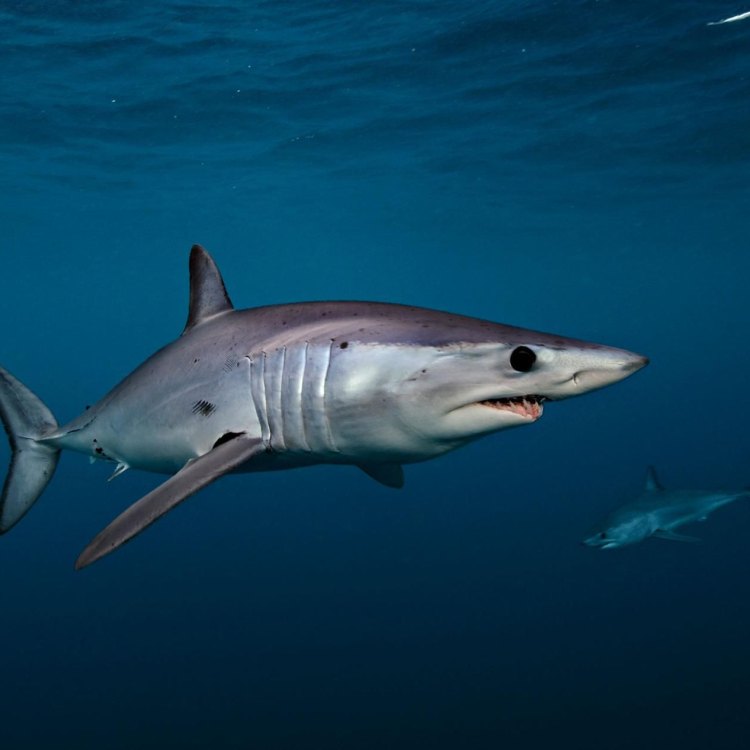
A Majestic Creature of the Open Ocean: The Longfin Mako Shark
Disclaimer: The content provided is for informational purposes only. We cannot guarantee the accuracy of the information on this page 100%. All information provided here may change without prior notice.










